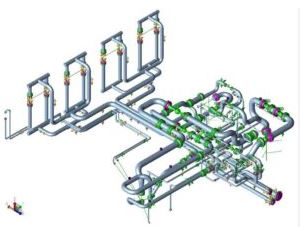
Basic Theory for Finite Element Analysis (FEA) and Implementation in the Framework of ASME Sec VIII D2 Part 5

Anindya Bhattacharya
Asset Engineer
$ 320
1 already enrolled!
Advanced course for professionals

Basic Theory for Finite Element Analysis (FEA) and Implementation in the Framework of ASME Sec VIII D2 Part 5
Trainers feedback
4
(23 reviews)
Anindya Bhattacharya
Asset Engineer
Course type
Instructor led live training
Course duration
14 Hrs
Course start date & time
October 11, 2025 | 08:01 AM
Language
English
This course format is where trainer will explain you the subject via online live session. This course will run as per specific date and time.
Why enroll
Here are some strong reasons why participants should join this online course:
1. Gain specialized knowledge in applying FEA according to ASME Section VIII, Division 2, Part 5—crucial for pressure vessel design and certification.
2. Learn only the necessary theoretical minimum, streamlining your understanding without overwhelming complexity—ideal for professionals who want clarity and focus.
3. Go beyond theory to understand how to implement FEA in real-world engineering scenarios, with a focus on stress classification, failure modes, and verification.
4. Bridges the Gap Between Theory and Industry Practice
5. Understand how FEA is used in actual Code compliance, which is often missing in general FEA courses.
6. Improves Confidence in Design-by-Analysis Methods
7. Avoid the trial-and-error approach by learning a concise, curated path designed specifically for pressure vessel engineers.
8. Mastering FEA for Code compliance is a highly valued skill in oil & gas, power, and process industries—making you a more competitive and capable engineer.
Opportunities that awaits you!

Earn a course completion certificate
Add this credential to your LinkedIn profile, resume, or CV. Share it on social media and in your performance review
Course details
This course aims to provide a rigorous and application-focused foundation in the theoretical minimum required for understanding and applying Finite Element Analysis (FEA), specifically within the framework of ASME Section VIII, Division 2, Part 5. The course is designed for engineers and professionals involved in pressure vessel design and analysis, who seek a deep yet streamlined grasp of the essential mathematical and physical concepts underlying FEA.
Participants will first be introduced to the fundamentals of solid mechanics, variational methods, and the finite element formulation of structural problems. Emphasis will be placed on interpreting stress-strain behavior, boundary conditions, and convergence requirements critical to accurate simulations. Building upon this foundation, the course will transition into practical implementation aspects, including mesh design, element selection, and verification strategies.
A core focus of the course is on applying FEA to meet the rigorous design-by-analysis requirements of ASME Sec VIII, Div 2, Part 5. This includes stress classification, elastic-plastic analysis, fatigue evaluation, and compliance with failure modes specified in the Code. By the end of the course, participants will be equipped with both the theoretical insight and practical tools to confidently apply FEA for Code-compliant design and evaluation of pressure-containing components.
The total duration of the online live course will be around 14 hours which will be conducted on 5 consecutive Saturdays (1:30 PM IST to 4:30 PM IST) starting from 4th October 2025 onwards.
Course suitable for
Oil & Gas Energy & Utilities Chemical & Pharmaceutical Mechanical Piping & Layout Civil & Structural
Key topics covered
What is Finite element analysis? Difference between analytical, finite element , finite difference and boundary element methods.
The two approaches- Galerkin and Principle of minimum potential energy. How governing equations are developed for FEA?
Displacement based approaches and other approaches of finite element analysis for structural mechanics.
Element formulation- linear and higher order displacement functions.
Different element types including their higher order versions- beam elements, triangular, quadrilateral, 3D elements, plate and shell elements,
How to choose elements for an application?
Mesh generation, mesh grading, element distortions, their allowable limits. Their effect on analysis results.
Solutions of FE equations. Integration orders, reduced and full integration. Their effects. Brief overview of shear and membrane locking., rigid body modes, phantom modes, hourglass modes.
Averaging vs non-averaging, convergence check.
Post processing of FE results for piping and pressure vessel analysis.
A brief overview of FE analysis for thermal/heat transfer problems.
A brief overview of design by analysis rule of ASME SEC VIII D2 Part 5.
How FE theory is incorporated in ASME SEC VIII D2 Part 5.
Element of theory of plasticity, its incorporation in ASME SEC VIII D2 Part 5 and its FE implementation. Brief overview of Riks algorithm.
FE analysis of bucking/elastic/elastic-plastic instability problems and its implementation in the framework of ASME SEC VIII D2 Part 5.
Training details
This is a live course that has a scheduled start date.
Live session
October 11, 2025 | 08:01 AM
2.8 Hours every day
5 Days
Why people choose EveryEng
Industry-aligned courses, expert training, hands-on learning, recognized certifications, and job opportunities—all in a flexible and supportive environment.
- Industry Veteran
- Trainer Review
$ 320
October 11, 2025
Questions and Answers
A: Finite Element Analysis (FEA) is a numerical method used to solve complex engineering and physical problems. It involves breaking down a large system into smaller, simpler parts called finite elements. These elements are interconnected at points called nodes. By applying equations that govern physical laws, FEA calculates how each element behaves under various conditions such as stress, heat, or vibration. The collective behavior of these elements gives an approximate solution to the entire problem. For an introduction, you might refer to the "Introduction to Finite Element Analysis" section on [NASA's FEA resources](https://www.grc.nasa.gov/WWW/Structures/FEA.html).
A: ASME Boiler and Pressure Vessel Code Section VIII Division 2 Part 5 provides detailed rules and requirements for performing Finite Element Analysis on pressure vessels. It establishes the design criteria, allowable stresses, and validation procedures needed to ensure safety and compliance when using FEA as part of the design or assessment process. This section emphasizes the importance of mesh quality, boundary conditions, load applications, and documentation to produce reliable and verifiable results. More information on these requirements can be found in the official ASME Boiler and Pressure Vessel Code documentation or summarized in various engineering standards resources such as [ASME's website](https://www.asme.org/codes-standards).
A: Key material properties required include the elastic modulus (Young's modulus), Poisson's ratio, yield strength, ultimate tensile strength, and allowable stress values specific to the material used in the pressure vessel. Time-dependent properties like creep or fatigue characteristics may also be relevant, depending on operating conditions. These properties must be derived from certified material data and consistent with the ASME code requirements to ensure the integrity and safety of the pressure vessel under applied loads. For detailed material property requirements, see ASME Sec VIII Div 2 Part 5 and relevant material specifications such as ASTM standards.
A: Mesh quality and refinement are critical in FEA to obtain accurate and reliable results. ASME Sec VIII Div 2 Part 5 stresses the need for an adequately refined mesh, particularly in regions of high stress gradients such as nozzles, welds, or geometric discontinuities. Poor mesh quality can lead to inaccurate stress predictions, convergence issues, or unsafe designs. Techniques such as mesh convergence studies, using appropriate element types, ensuring aspect ratio within acceptable limits, and applying local refinement where necessary are recommended best practices. More detailed guidance can be found in specialized FEA textbooks like "The Finite Element Method" by O.C. Zienkiewicz and code-related application notes.
A: The loads usually considered include internal and external pressure, dead weight, thermal expansion, seismic loads, wind loads, and any operational loads such as nozzle forces and moments. The ASME code specifies load combinations that must be analyzed to ensure safety under all plausible scenarios. Additionally, dynamic effects or cyclic loading might be examined depending on the vessel's service conditions. Properly defining these loads per code requirements and applying them correctly in the FEA is essential to comply with ASME Sec VIII Div 2 Part 5.
A: Acceptance criteria in ASME Sec VIII Div 2 Part 5 are based on stress limits derived from allowable stresses and defined stress categories such as primary, secondary, and peak stresses. The code requires that calculated stresses do not exceed these limits to avoid plastic deformation or fatigue failure. For example, primary membrane stresses must remain within allowable stress to ensure structural integrity, while fatigue checks apply to secondary and peak stresses. The part also outlines safety factors and recommended evaluation procedures. Detailed criteria can be found in the code itself, which should be reviewed carefully during the design and verification stages.
A: Boundary conditions simulate constraints and interactions between the pressure vessel and its environment or support structures in an FEA model. Accurately defining these conditions is vital because they influence stress distribution and deformation results. ASME Sec VIII Div 2 Part 5 requires that boundary conditions reflect realistic physical restraints such as fixed supports, symmetry, and load transfers to adjacent components. Incorrect or oversimplified boundary conditions may produce inaccurate results and non-conservative designs. Proper documentation and justification of boundary conditions are also required for code compliance.
A: Common challenges include modeling complex geometries, achieving mesh convergence, defining realistic loads and boundary conditions, and interpreting stress results within code limits. Additionally, ensuring material property accuracy and validating the model against experimental or analytical solutions are vital. These challenges can be addressed through thorough training, use of proven software tools, applying mesh refinement strategies, performing sensitivity analyses, and adhering strictly to ASME Sec VIII Div 2 Part 5 guidelines. Peer reviews and quality assurance processes also enhance the reliability of FEA implementations.
A: Several commercial FEA software packages such as ANSYS, Abaqus, and Siemens NX have capabilities to perform analyses compliant with ASME Sec VIII Div 2 Part 5 requirements. These tools offer specialized modules for pressure vessel design, including predefined material libraries, load cases, and automated report generation aligned with code standards. However, compliance depends on the user's expertise and correct application of the tools in accordance with the code. It's crucial to validate the software setup for specific projects and maintain documentation demonstrating ASME conformance. For further details on software compliance, consult vendor documentation and ASME guidelines.
A: Fatigue analysis is essential for pressure vessels subjected to cyclic loading. ASME Sec VIII Div 2 Part 5 incorporates fatigue design rules that require assessment of stresses over repeated load cycles to prevent crack initiation and propagation. FEA helps calculate stress ranges and identify critical areas prone to fatigue damage. The code provides allowable stress ranges and cumulative usage factors to evaluate service life. Integration of fatigue with FEA includes applying appropriate load spectra, assessing secondary and peak stresses, and using cycle counting methods. Consult the ASME BPVC Fatigue Design and Analysis section along with FEA results to ensure compliance.
More from Same Author
- Technical Courses
- Articles
4 (19)
Watch to learn anytime
84
28
E-Learning
Unlimited access
Instructor led live training
143
Online
Live courses
October 13
15 Hrs
5
Instructor led live training
927
195
Online
Live courses
September 15
1 Hrs
Earning and Growth option in same Industry Domain
- Pre-recorded
- Online live session
- Offline
- Articles
4 (19)
Watch to learn anytime
28
E-Learning
Unlimited access
4 (17)
Watch to learn anytime
869
7
E-Learning
Unlimited access
4
Watch to learn anytime
1444
2
E-Learning
Unlimited access
More Training & Development option to expand your reach
- Technical courses
- Soft-skill courses
- Seminars & Conferences
- Articles & Blogs
5
Instructor led live training
459
1
Online
Live courses
September 22
9 Hrs
Beginner
4 (23)
Instructor led live training
335
1
Online
Live courses
October 11
14 Hrs
Advanced
4 (23)
Instructor led live training
541
Online
Live courses
October 11
4 Hrs
Intermediate























